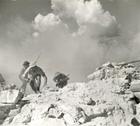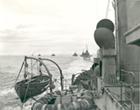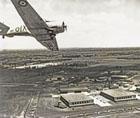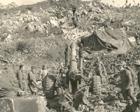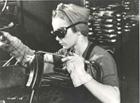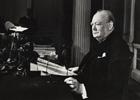|
"Finest hour": the British Commonwealth at warDownload "Finest hour": the British Commonwealth at war (Complete version) in PDF format (110Kb)
Britain and the dominion nations were the only powers that fought in the war from its beginning in September 1939 to its end in August 1945. Their forces served in all theatres of war, from the gale-swept wastes of the Atlantic, to the skies over Europe, the forests and fields of Europe, the deserts of North Africa and the jungles and seas of southeast Asia. Each nation was wholly committed to the war effort, and some (notably Britain but also Australia) suffered direct attack. The twentieth century saw the transformation of Empire into Commonwealth, and the Second World War was a critical phase of intense change. The war challenged British tendencies to regard the interests of Britain and its dominions as uniform, and each nation's response to war reflected a growing awareness that it was always possible national interests might prevail over the common cause. For example, while Australia immediately followed Britain in declaring war on Germany, other dominions took a more independent stance. Canada debated for seven days whether to enter the war. Later in the war the opposite tendency was seen. While unthreatened Canada contributed troops to the war in Italy and northwest Europe, the Australian government decided to withdraw most of its forces from Europe and concentrate its war effort against the Japanese threat at home. Each weighed its national interests against the implications of membership of empire and alliance. The Commonwealth's members often fought quite different wars, concentrating on some theatres of war and not on others. The mix influenced both the experience and the memory of war for the three nations. Canada's memory of the war is overwhelmingly of the Atlantic - in 1945, its navy was the largest after those of the major powers - or of the liberation of western Europe. While Australians served in both the Commonwealth's Eighth Army and in Bomber Command, its predominant memory is of the war against Japan. Britain, as the major Allied power (at least up to the entry into the war of the United States) provided forces in almost every theatre. For six years it sustained large forces in several major theatres: in the Atlantic, in the air war over Europe, in North Africa and the Mediterranean, and in southeast Asia. There was hardly any area of the war in which the British Commonwealth did not contribute. Perhaps the most striking example of Commonwealth cooperation was in the air war over Europe, and especially in the bomber offensive. The Empire Air Training Scheme (later the British Commonwealth Air Training Plan) took trainees from Britain and all of the dominions and at training stations located across Canada turned out aircrew for the Commonwealth's air forces. This created a truly "Commonwealth" air force, distinguished by uniform but united by language, culture, training, slang, and - not least - shared risk. In all three nations the vast bulk of the armed forces comprised civilians who became soldiers, sailors or airmen for the duration. While Britain had supplemented its regular and reserve forces with a conscription scheme dating from before the war, for both Australia and Canada overseas service remained largely a voluntary matter, though later in the war Australian conscripts fought in New Guinea and the islands. In all three countries men, and increasingly women, became deployable "manpower" able to be drafted into the services or to industry. The demands of the services and the war economy bit particularly deeply in Britain itself, in which a massive proportion of the population was committed to the services, war production, or war-related voluntary work. Australia and Canada each lost 40,000 dead from forces each totalling about a million. Britain, with 47 million people, lost over 300,000 dead, a disproportionately heavy toll partly explained by Britain's civilian casualties, both in bombing and in the Merchant Navy. In Australia and Canada all but a few hundred of the dead were members of the services, the vast majority of whom died overseas. Australia's losses relative to population (seven million compared to Canada's 11 million) were incurred because a substantial proportion (over 8,000) died as prisoners of the Japanese. Because of its greater commitment to the air force over Europe, however, as many Canadians died in the Royal Canadian Air Force as did Australians in the entire war against Japan: about 17,000. Thus each of the nations of the Commonwealth had reason to regret and remember the sacrifices exacted in the war. It is salutary to be reminded, however, that still greater were the losses suffered by the defeated nations of Germany and Japan or the war's major victims, the Soviet Union and China.
Britain itself and the two largest dominions, Australia and Canada, took the brunt of the Commonwealth's war effort in the Second World War. (India's contribution as a whole dwarfed those of the so-called "white" dominions, of course; but an independent India soon lost interest in a war perceived as having been fought for empire.) Sixty years on, then, the world has changed. Virtually all of the countries that had been part of the Empire have achieved independence. The Commonwealth has changed too, though not out of all recognition. The ties that drew the Commonwealth to support the war effort between 1939 and 1945 remain, if in attenuated form. Now united by a sometimes fragile compound of sentiment, heritage, friendship, sport and shared values (not always equal to the pressures of economic interest), the Commonwealth remains an important world forum. On the anniversary of final victory, what was widely regarded as the Commonwealth's finest achievement, it is fitting to recall the joint exertions and successes of the Commonwealth at war. Peter Stanley
|
|
|
 |
 |
